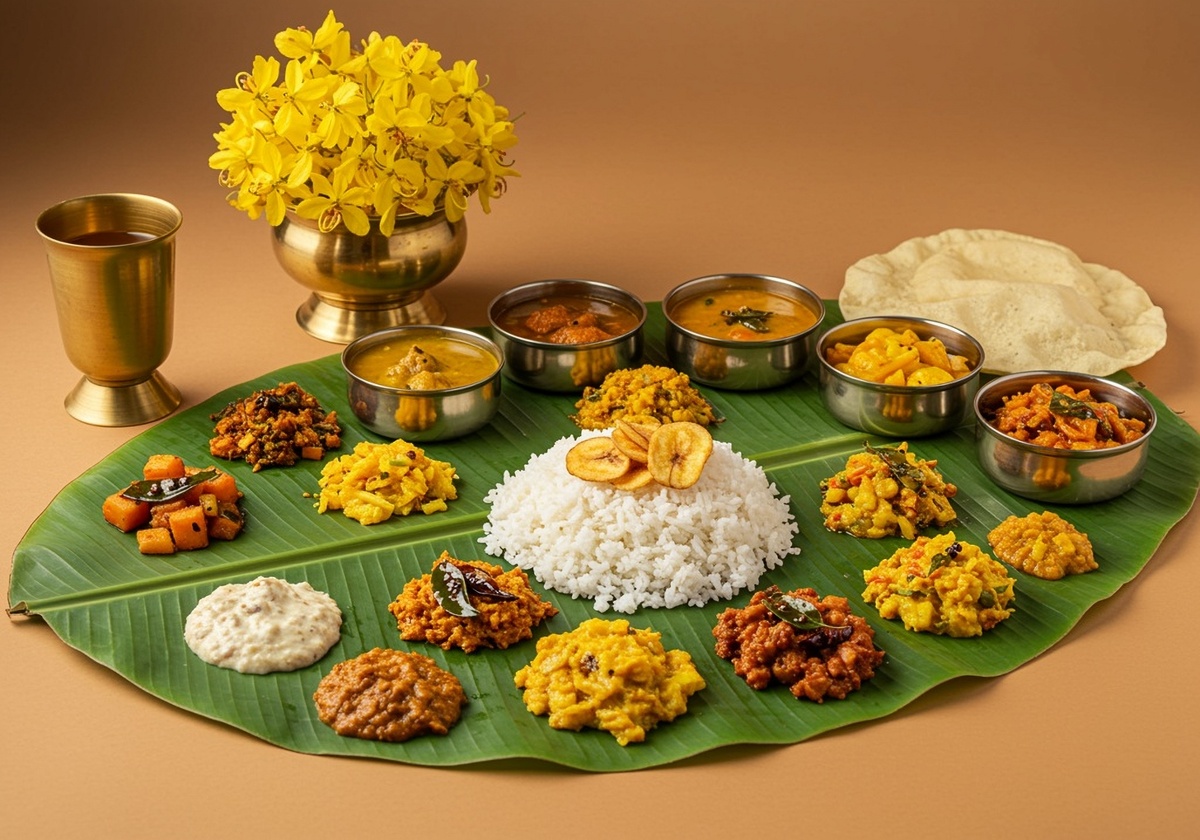August 17, 2022
Onam Sadhya: A Complete Guide to Kerala’s Grand Harvest Feast
CM Content Team


View all
140+
Resorts
August 17, 2022
CM Content Team
In Kerala, the arrival of Onam is more than a change in the calendar; it’s the season when tradition steps into the present. The streets bloom with intricate pookalam (floral rangoli) designs, boats slice through backwaters in thrilling races, and homes come alive with the scent of fresh coconut, jaggery, and curry leaves. But amid the music, dances, and rituals, there is one tradition that unites every Malayali household and captivates food lovers worldwide, the Onam Sadhya.
Served on a banana leaf, this grand vegetarian banquet can feature up to 30 different dishes, each with its own history, symbolism, and flavour profile. More than just a meal, it is a cultural mosaic, one that celebrates harvest abundance, honours heritage, and reinforces the joy of sharing. Whether you are in a small village kitchen or a comfortable heritage resort, Onam Sadhya remains a powerful symbol of Kerala’s warmth and hospitality.

The word Sadhya in Malayalam means “banquet,” and during Onam, it refers to an elaborate vegetarian feast prepared on Thiruvonam, the festival’s main day. Onam itself commemorates the legendary King Mahabali, whose reign is remembered as a golden era of equality, prosperity, and joy. According to tradition, Mahabali visits his people once a year during Onam, and the Sadhya is a way to welcome him back.
In the past, Onam Sadhya was a purely home-cooked affair, neighbours contributing ingredients, relatives sharing duties, and the women of the house working together from the early hours of dawn. Today, while some still follow this tradition, restaurants and community halls also host lavish Sadhyas, especially for those living outside Kerala or in urban apartments. But no matter where it’s enjoyed, the essence of Onam Sadhya remains the same: a showcase of Kerala’s agricultural wealth, culinary artistry, and community spirit.

Preparing items for Onam Sadhya is not a solitary task; it’s a celebration of togetherness. In many neighbourhoods, relatives and friends gather in one home to cook, chop vegetables, grind coconut pastes, and stir pots of fragrant curries. Elders guide the process, ensuring each dish meets traditional standards, while children help set up banana leaves or make small snacks.
The entire exercise is as much about the process as it is about the result. Conversations flow, stories are shared, and laughter fills the air. By the time the dishes are laid out, the feast already carries the flavour of togetherness.

While the number of dishes for Onam Sadhya varies between families and regions, a full festive spread can easily cross 20 to 25 items. Here’s a detailed guide to the essentials:
Choru (Rice) – Usually Kerala red rice (matta), served in generous mounds. Its earthy flavour and slightly chewy texture make it the perfect base for soaking up curries and gravies.
Parippu Curry – Moong dal cooked with coconut, cumin, and turmeric, eaten with ghee. This golden, creamy lentil dish is often the first course mixed with rice, signalling the start of the Sadhya feast.
Rasam – Spicy, tangy broth flavoured with tamarind, pepper, and curry leaves. Light yet invigorating, it acts as a palate cleanser and digestive aid between heavier dishes.
Sambhar – Lentil-based curry with tamarind and vegetables like drumstick, okra, or pumpkin. The tang from tamarind balances beautifully with the earthy lentils, while the medley of vegetables adds texture and depth. It’s a cornerstone of South Indian cuisine, bringing warmth and familiarity to every Onam Sadhya plate.
Avial – A mixed vegetable dish in a coconut-yoghurt sauce, fragrant with curry leaves. Brightly coloured vegetables create a feast for the eyes, while the coconut-yoghurt blend offers a creamy, tangy flavour.
Olan – Mild curry of ash gourd and black-eyed beans simmered in coconut milk. Delicate and subtle, Olan’s flavours are gentle on the palate, offering a calming contrast to the spicier dishes. Its smooth, milky texture and light seasoning make it a favourite for those seeking a comforting side.
Theeyal – Tangy curry with roasted coconut and spices, often with shallots or eggplant. The roasting of coconut and spices gives Theeyal a deep, almost smoky undertone. Every spoonful carries layers of sweet, sour, and spicy, making it one of Kerala’s most complex curries.
Mor Curry – Yoghurt-based curry with seasonal vegetables. The tang of yoghurt is balanced with gentle spices, resulting in a light yet flavourful dish. Often served towards the end of the meal, Mor Curry cools the palate and aids digestion.
Papadam – Crisp fried lentil wafers. Light, airy, and shatteringly crisp, they add a delightful crunch to every bite of the meal. Their neutral flavour makes them the perfect companion to both spicy curries and sweet payasam.
Kaaya Varuthathu – Thin, salty banana chips. Fried to a golden crisp, these chips offer a salty, savoury hit that pairs beautifully with rice. A true Kerala classic, they’re often the first thing diners snack on before the main feast begins.
Sarkara Upperi – Banana chips coated in jaggery syrup. Sweet, sticky, and crunchy, each bite delivers the comforting taste of caramelised jaggery. This sweet treat balances the savoury dishes, making it an irresistible palate-pleaser.
Chena Varuthathu – Fried yam slices with spice seasoning. Crisp on the outside and soft within, these yam fritters are packed with earthy flavour. The spice mix clings to each piece, offering a gentle heat that lingers pleasantly.
Puli Inji – Sweet-sour ginger-tamarind relish. A harmonious blend of fiery ginger heat, tamarind tang, and jaggery sweetness. It’s the burst of bold flavour that wakes up your taste buds and cuts through the richness of the curries.
Mango & Lemon Pickles – Spicy and tangy, made with seasonal produce. The tartness of raw mango or lemon is intensified with red chilli, mustard seeds, and coconut oil. These pickles mature over time, their flavours deepening into a fiery, tangy punch that elevates the Sadhya.
Thoran – Stir-fried vegetables with coconut. Freshly grated coconut lends sweetness and texture to finely chopped vegetables like beans, cabbage, or carrots. Seasoned with curry leaves and mustard seeds, it’s a bright, wholesome side that adds freshness to the feast.
Paal Payasam – Creamy rice pudding with milk, sugar, and cardamom. Silky and delicately sweet, it’s the quintessential finale to any Sadhya. The gentle aroma of cardamom lingers long after the last spoonful, leaving a comforting warmth.
Ada Pradhaman – Rice flakes in jaggery-coconut milk syrup. The deep caramel notes of jaggery meld perfectly with the creaminess of coconut milk. Each bite feels like a festival in itself, rich, indulgent, and layered with texture.
Pazham Pradhaman – Banana-based dessert rich with ghee and coconut. The sweetness of ripe bananas is heightened by the nuttiness of roasted coconut and the richness of ghee. Its velvety texture makes it one of the most splendid payasams in the Onam repertoire.

Serving Onam Sadhya on a banana leaf is as symbolic as it is practical. The leaf acts as a natural, biodegradable plate and adds a subtle aroma to hot dishes. Scientifically, banana leaves are rich in antioxidants and have antimicrobial properties. Plus, the bright green leaf makes the whole meal look colourful and festive.
The broad end of the banana leaf should always be placed on the diner’s right side, as per tradition. This arrangement is not just for appearance; it’s believed to make eating easier and more comfortable. The first thing served is a pinch of salt, allowing diners to season any dish to their liking. Next, the dry items, such as chips, pickles, and stir-fried vegetables, are arranged neatly along the top half of the leaf. The rice and curries take their place at the bottom, leaving space for generous servings and easy mixing.
Eating is done with the right hand only, a practice rooted in both custom and health beliefs. Using your fingers allows you to feel the texture and temperature of the food, which is thought to aid digestion and create a deeper connection with the meal. It’s also a way to slow down, be mindful, and truly enjoy every bite of the Onam Sadhya.
The Onam Sadhya is naturally plant-based, making it both eco-friendly and healthy. Fresh vegetables, pulses, and fruits are locally sourced, ensuring freshness and flavour. Most dishes in Onam Sadhya are steamed, boiled, or lightly sautéed, which helps keep their nutrients intact.
Coconut, in grated, milk, or oil form, adds healthy fats, while spices like turmeric, ginger, pepper, and curry leaves not only enhance taste but also offer health benefits inspired by Ayurveda. Together, these elements make the Sadhya a meal that’s good for both body and soul.
While the traditional items for Onam Sadhya are widely recognised, each region of Kerala adds its own unique touch. In southern Kerala, you might find Kootu Curry, a delicious sweet-and-savoury dish made with black chickpeas, plantains, and grated coconut. In northern Kerala, Kalathappam, a fragrant rice cake cooked with coconut and jaggery, might be served as a dessert.
Outside India, Malayali communities recreate the feast using ingredients available locally, sometimes introducing creative fusion elements, like quinoa instead of rice or dairy-free payasams, while keeping the spirit and traditional presentation intact. These variations show how Sadhya can adapt to different kitchens without losing its cultural heart.
If you’re in Kerala during Onam, there are many ways to experience the magic of a traditional Sadhya. You can join community feasts hosted in temples and town halls, where long rows of banana leaves are laid out and hundreds of people are served together.
Cultural resorts often recreate the traditional ambience with live music, floral decorations, and servers dressed in traditional attire, making the meal feel like a grand celebration.
For a more personal experience, choose homestays where local families invite guests to share the Sadhya with them, often along with stories, customs, and warm hospitality.
Pro tip: Arrive hungry and with an open mind, because it’s customary (and considered polite) to accept at least one refill of your favourite dishes, and trust us, you’ll want to.
The Malayalam saying “Kaanam vittum Onam unnanam” translates to “Even if you have to sell your property, have the Onam feast”, a powerful reminder of how deeply the Sadhya is valued in Kerala’s culture. It reflects the belief that the joy and togetherness of Onam are worth any sacrifice.
Every dish placed on the banana leaf has a purpose, ensuring a perfect balance of tastes, textures, and colours, from tangy pickles at the top to creamy curries and rice at the bottom. This careful arrangement not only follows tradition but also enhances the dining experience.
The pickles for Sadhya are a tradition in themselves, always vinegar-free and preserved using oil and a blend of spices. Often made from seasonal produce like mango, lemon, or gooseberry, they add a burst of flavour that cuts through the richness of the feast.


For a comfortable and scenic stay during your Onam trip, consider Club Mahindra Mount Serene, Munnar. Surrounded by lush tea plantations and misty hills, this resort in Munnar offers a peaceful retreat with modern amenities. Its warm hospitality and local experiences make it a great base for exploring Kerala and enjoying an authentic Onam Sadhya.
With a Club Mahindra membership, you can enjoy memorable family holidays year after year at stunning destinations across India and abroad. Members get access to over 140+ Club Mahindra resorts worldwide, including premium stays like Mount Serene, Munnar, along with curated local experiences, festive celebrations, and comfortable accommodations. It’s a way to explore new places while enjoying the warmth and quality that Club Mahindra is known for.
Onam Sadhya is not just about food, it’s about connection, gratitude, and celebration. Each bite carries a story from Kerala’s soil, from the farmers who grew the vegetables to the generations who perfected the recipes. If you are planning to visit Kerala during the Onam festival, there is no better way to experience its spirit than by sitting down for a traditional Sadhya. Whether you savour it in a bustling Kochi household, at a serene riverside homestay, or even abroad, a true Sadhya will always feel like a welcome home.
Onam Ashamsakal! May your plate be full, your heart fuller, and your memories of Sadhya last long after the festival ends.
Mahindra Holidays & Resorts India Ltd. (MHRIL), a part of Leisure and Hospitality sector of the Mahindra Group, offers quality family holidays primarily through vacation ownership memberships and brings to the industry values such as reliability, trust and customer satisfaction. Started in 1996, the company's flagship brand ‘Club Mahindra’, today has over 300,000 members , who can holiday at 140+ resorts in India and abroad.
We use cookies to personalise content and to provide you with an improved user experience.By Continuing to browse this site you consent to the use of cookies.Please visit our cookie policy for further details.

Welcome to ClubMahindra.com In order to provide a personalised experience for you, we use cookies to enable some website functionality. Cookies help us see which articles most interest you; allow you to easily share articles on social media channels; permit us to deliver content personalised to your interests and locations; along with many other site benefits. For more information, please review our Cookie Policy
When you visit any website, it may store or retrieve information on your browser, mostly in the form of cookies. This information might be about you, your preferences or your device and is mostly used to make the site work as you expect it to. The information does not usually directly identify you, but it can give you a more personalized web experience. Because we respect your right to privacy, you can choose not to allow some types of cookies. Click on the different category headings to find out more and change our default settings. However, blocking some types of cookies may impact your experience of the site and the services we are able to offer.
Because we respect your right to privacy, you can choose not to allow some types of cookies and you have the right to withdraw your consent by send a mail to email id [email protected]
These cookies are essential in order to enable you to move around the site and use its features, such as accessing secure areas of the site. Without these cookies, services you have asked for cannot be provided.
These cookies allow us to employ data analytics so we can measure and improve the performance of our site and provide more relevant content to you. These cookies don't collect information that identifies a visitor down to an individual level that is available to us. These cookies are not passing personally identifiable information to any external third party other than in limited cases when we engage a service provider to act on our behalf but who is then unable to use the data for their own purposes.
Performance cookies are generally third-party cookies from vendors we work with or who work on our behalf that collect information about your visit and use of the Club Mahindra website, for instance which pages you visit the most often, and if you get error messages from web pages. These cookies don't collect information that identifies a visitor. All information these cookies collect is anonymous and is only used to improve your overall experience on how the website works. Third party vendors may have access to this data and may use it to improve their overall services and offerings.
Functionality cookies allow a site to remember choices you make (such as your user name, language or the region you are in) and provide more enhanced, personal features. These cookies cannot track your browsing activity on other websites. They don't gather any information about you that could be used for advertising or remembering where you've been on the Internet outside our site.
Third-party advertising and social media cookies are used to (1) deliver advertisements more relevant to you and your interests; (2) limit the number of times you see an advertisement; (3) help measure the effectiveness of the advertising campaign; and (4) understand people's behaviour after they view an advertisement. They are usually placed on behalf of advertising networks with the site operator's permission. They remember that you have visited a site and quite often they will be linked to site functionality provided by the other organization. This may impact the content and messages you see on other websites you visit. If you do not allow these cookies you may not be able to use or see certain these sharing tools content on our website.